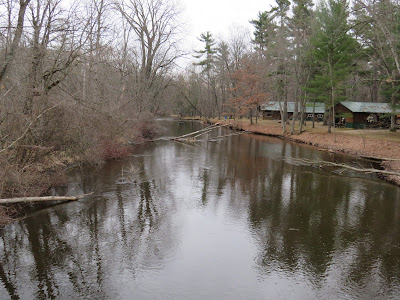The early morning sky is overcast and the temperature is in the mid 40’s as I begin my hike on the Lumberjack Park Nature Trail. Heading north, I follow the boardwalk, then turn east along the edge of Mud Creek and arrive at the footbridge where I pause to watch the creek water flow west through a stark early spring landscape while listening to the sound of a song sparrow and distant crow. Proceeding through a stand of Red and White pine, I turn south and head to the edge of the Pine River to watch a the gently flowing current while listening to the song of a Northern Cardinal and the alternate drumming of two woodpeckers. Depending on the reason for drumming, woodpeckers, like Downies, have drum trees (such as the hard wood at the top of a dead maple) that have special resonance. A male Downy may ascend such a place, trying successive spots with a few bursts on each, extracting a variety of sounds, some flat, some deep, and others loud and sharp, the effect being like the playing of a xylophone. Following the trail west along a steep bank, I pause at a bench to take in the scenic riparian landscape. Continuing west, I come to Lumberjack Rd. where I glance upward to the top of a telephone pole to see a perching adult Red-tailed hawk, displaying the colorful tail feathers for which it’s named. These raptors typically prey on reptiles, birds, and small mammals. Most prey is taken back to a feeding perch where it’s beheaded before being consumed. Birds, even small birds, are usually plucked of their feathers while small mammals are often swallowed whole. Redtails also feed on carrion, including roadkill. Crossing the road bridge, I follow the Campground trail along a wide rocky river channel as its water flows to the southeast. Continuing into the campground through a carpet of fallen leaves, I enjoy another song variation of the Northern Cardinal. Veering off the trail to the river’s edge, I look eastward to watch the water of Mud creek flow gently into the Pine River. Nearby, a sign of early spring catches my eye, the purplish hood-like bract of a Skunk Cabbage. Hidden inside this structure are numerous small, purple flowers growing on a small, oval, fleshy spike (stock photo). These flowers don’t need “attractive” petals because pollinators, like honeybees, are attracted to the heat and fetid odor the plants produce in early spring.
March bids farewell
Beside a cattail marsh
River’s open water
Wind no longer harsh
Stand of barren trees
Early morning sun
Banks surrender snow
Winter’s barely done
From the silent shore
Welcomed song is heard
Glad tidings of spring
Hail, redwing blackbird
D. DeGraaf

No comments:
Post a Comment